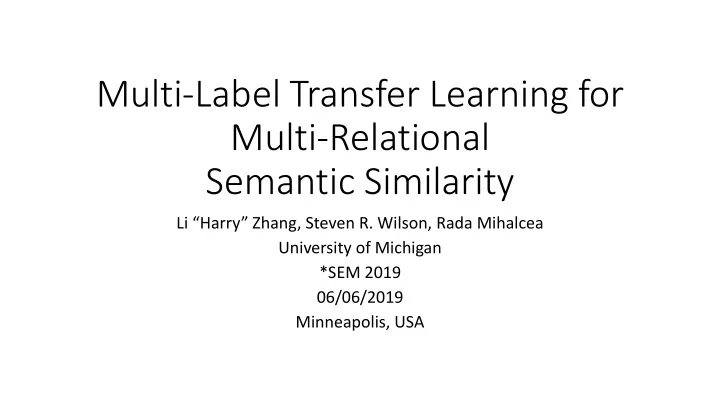

Multi-Label Transfer Learning for Multi-Relational Semantic Similarity Li “Harry” Zhang, Steven R. Wilson, Rada Mihalcea University of Michigan *SEM 2019 06/06/2019 Minneapolis, USA
Semantic Similarity Task • Given two texts, rate the degree of equivalence in meaning • Dataset: pairs of text & human annotated similarity, e.g. 0 – 5 scale • Example • I will give her a ride to work. • I will drive her to the company. • Similarity: 5 • Output: A machine predicts similarity scores for all pairs • Evaluation: Pearson/Spearman’s correlation • Existing datasets: Finkelstein et al. 2012, Agirre et al. 2012-2016, Cer et al. 2017, Hill et al. 2015, Leviant et al. 2015, etc.
Multi-Relational Semantic Similarity Task • “Similarity” can be defined in different ways, i.e. relations • Some datasets are annotated in multiple relations of similarity • Human Activity : similarity, relatedness, motivation, actor (Wilson et al. 2017) • SICK : relatedness, entailment (Marelli et al. 2014) • Typed Similarity : general, author, people, time, location, event, action, subject, description (Agirre et al. 2013)
Human Activity • Similarity: do the two activities describe the same thing? • Relatedness: are the two activities related to one another? • Motivation: are the two activities done with the same motivation? • Actor: are the two activities likely to done by the same person? “Check email” vs. “write email” (scale of 0 -4): Similarity Relatedness Motivation Actor 1.8 3.3 2.6 3.2
SICK • Sentences Involving Compositional Knowledge • Relatedness: are the two texts related to one another? (scale 1-5) • Entailment: does one text entail the other? (three-way) “Two dogs are wrestling and hugging” vs. “There is no dog wrestling and hugging Relatedness Entailment 3.3 Contradict
Typed Similarity • A collection of meta-data describing books, paintings, films, museum objects and archival records (scale of 0-5) Title : Serpentine Bridge, Hyde Park, Westminster, Title : London Bridge, City of London Greater London Creator : not known Creator : de Mare, Eric Description : A view of London Bridge which is Subject : Waterscape Animals Bridge Gardens And packed with horse-drawn traffic and pedestrians. Parks This bridge replaced the earlier medieval bridge Description : The Serpentine Bridge in Hyde Park seen upstream. It was built by John Rennie in 1823-31. from the bank. It was built by George and John A new bridge, built in the late 1960s now stands Rennie, the sons of the geat architect John Rennie, in on this site today. 1825-8. general author people time location event subject description 4.2 2.6 3.0 5.0 4.8 2.8 4.0 3.2
Existing Model: Single Task • Fine-tuning with pre-trained sentence encoder / sentence embeddings • InferSent: Bi-LSTM with max pooling (Conneau et al. 2017) • A logistic regression layer is used as the output layer • All parameters are being tuned during transfer learning
Existing Model: Single Task • Treats each relation as a single separate task Relation A: LSTM Out • No parameter or information is shared among relations of similarity Relation B: LSTM Out • The Single-Task baseline • Question: can we learn across different relations, by sharing parameters?
Proposed Multi-Label Model • Same sentence encoder model • All relations share the lower-level parameters in the LSTM • Each relation has its own output layers • Each output layer makes a prediction at the same time
Proposed Multi-Label Model • Assuming 2 relations (A and B) Relation A: • One output layer per relation Out • The rest of the parameters are shared LSTM between the 2 relations Relation B: Out • The 2 losses are summed as the final loss • All parameters in the model are updated • The Multi-Label model
Alternative Multi-Task Model • Same sentence encoder model • Alternate between batches of different relations • Update the related parameters each time
Alternative Multi-Task Model • Same sentence encoder model • Alternate between batches of different relations • Update the related parameters each time
Alternative Multi-Task Model • Same sentence encoder model Relation A: • Assuming 2 relations (A and B) Out • Still 2 output layers LSTM • Take a batch of pairs, predict relation A Relation B: Out • Update parameters • Take a batch of pairs, predict relation B Relation A: Out • Update parameters LSTM • The Multi-Task model Relation B: Out
Comparison Between the Models Relation A: Out • Multi-Label Learning (MLL) LSTM Relation B: Out Relation A: LSTM Out • Single-Task Learning (Single) Relation B: LSTM Out A: A: Out Out LSTM LSTM • Multi-Task Learning B: B: Out Out
Results • ↑ means MLL outperforms by a statistically significant margin Human Activity dataset (Spearman’s correlation) • ↓ means MLL underperforms by a statistically significant margin • Multi-Label Learning (MLL) setting has the best performance mostly SICK dataset (Pearson’s correlation) Typed- Similarity dataset (Pearson’s correlation)
Discussion and Conclusion • Multi-Label Learning is a simple but effective way to approach multi- relational semantic similarity tasks • Learning from one similarity relation helps with learning another • The idea can be applied to any kind of fine-tuning setting (e.g. graph encoder, language model) used in any multi-label datasets • Further questions and discussions can be directed to Li Zhang (zharry@umich.edu)
Recommend
More recommend